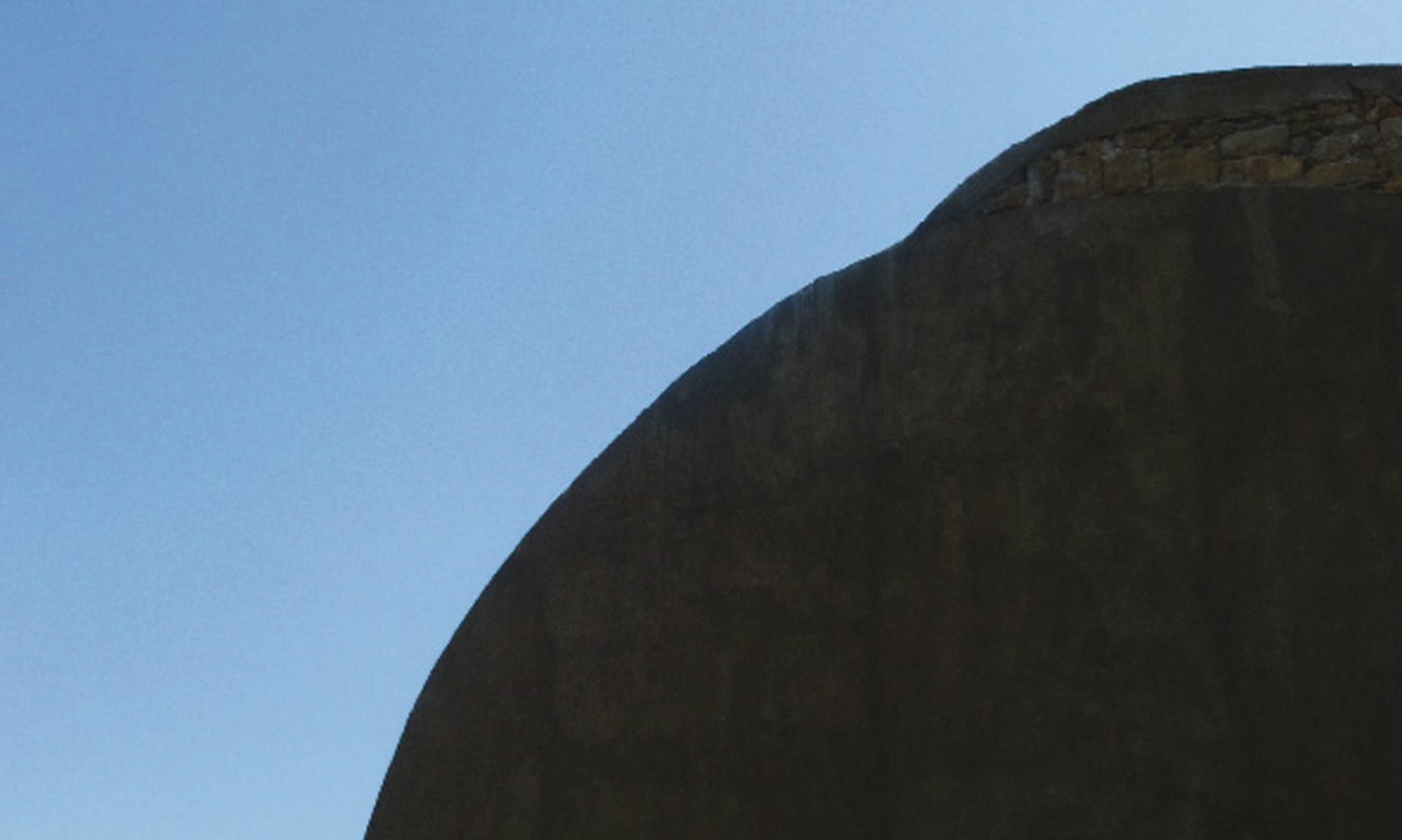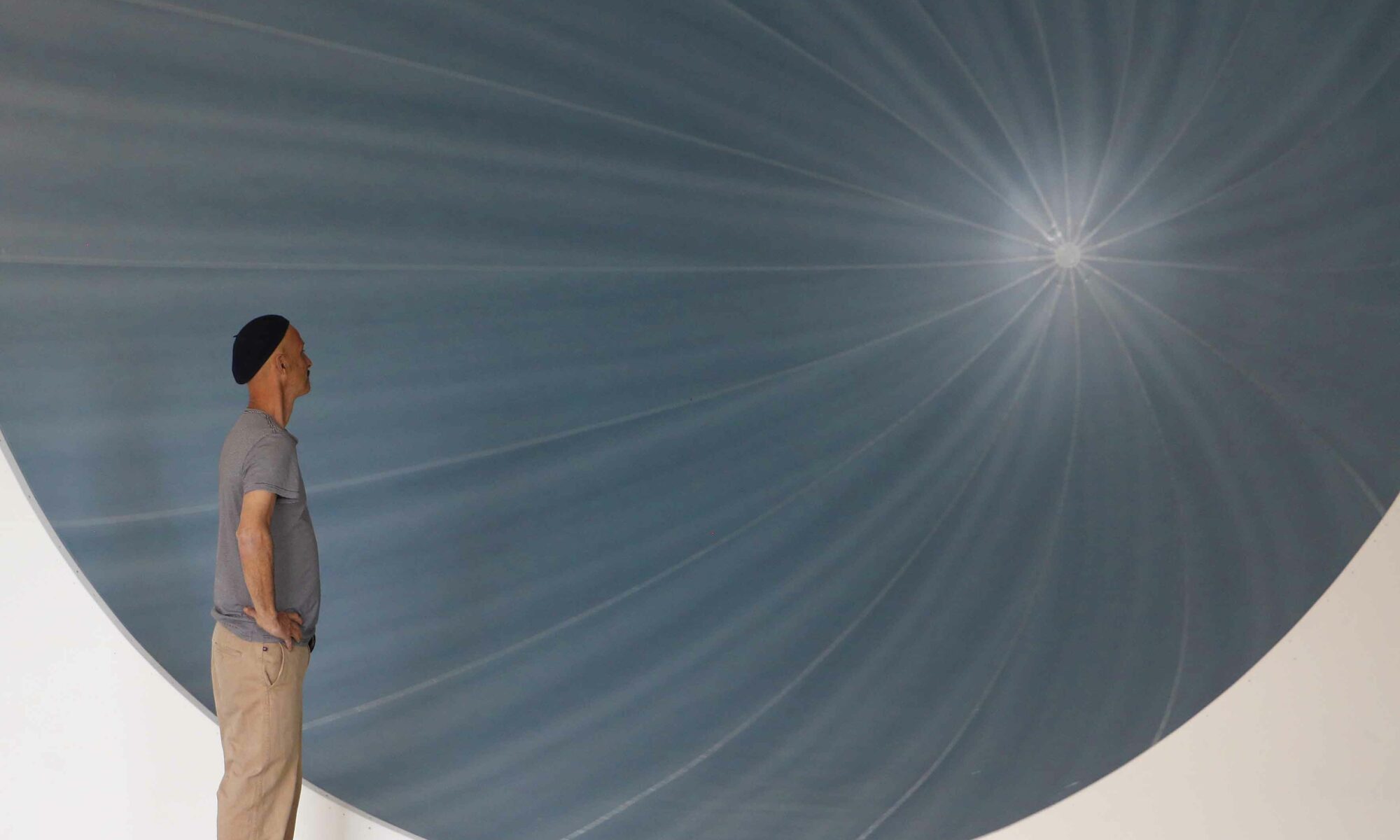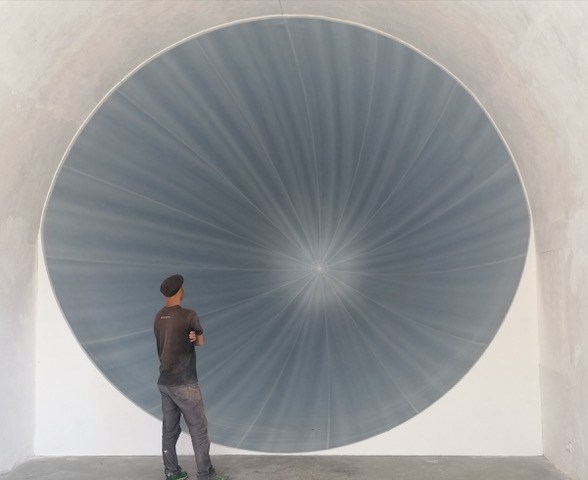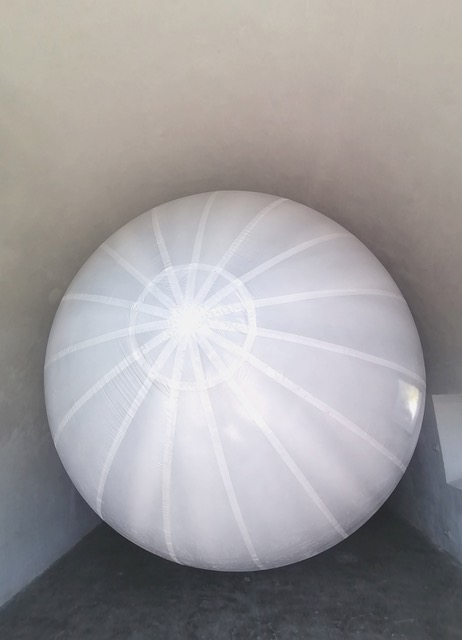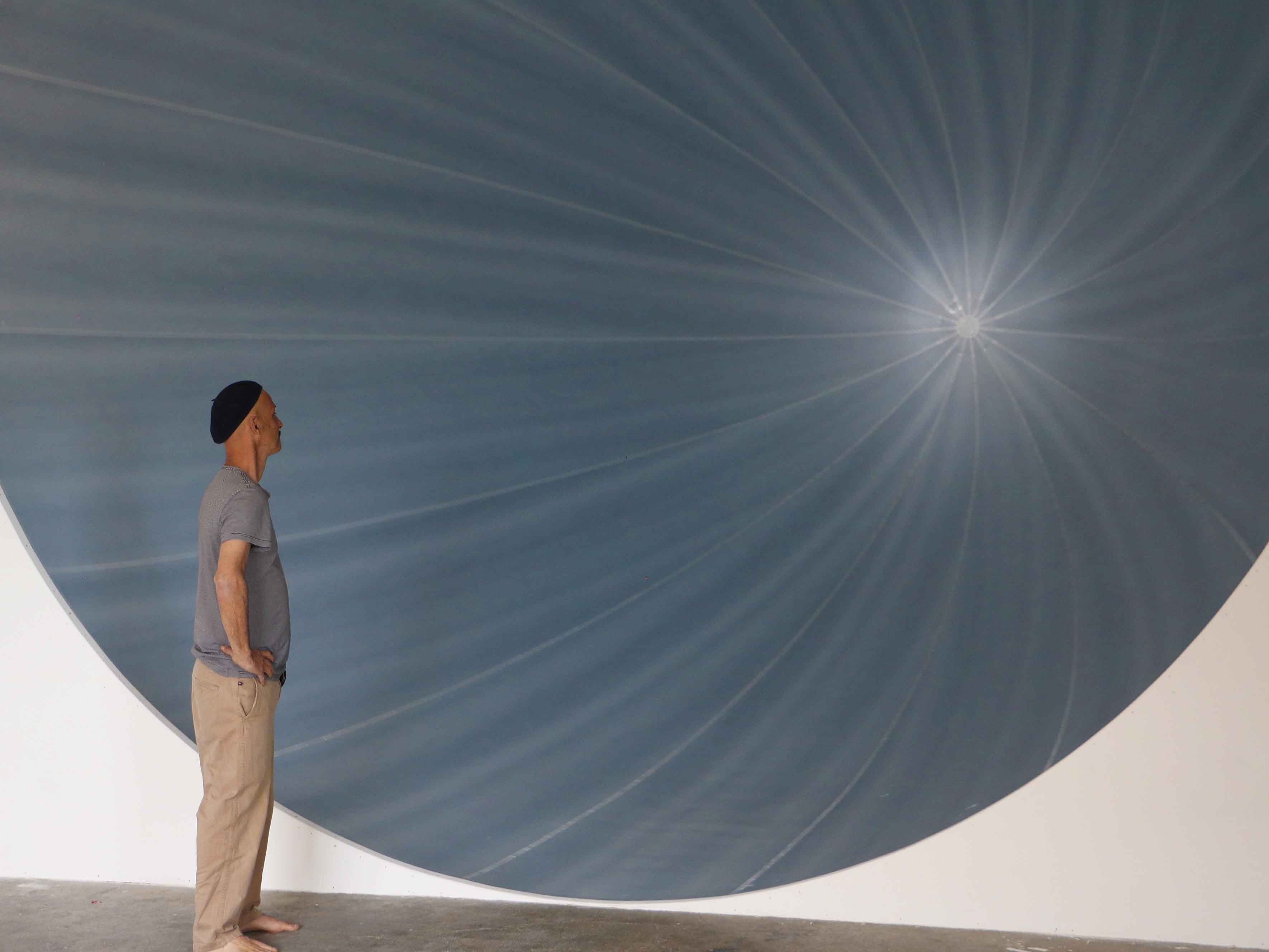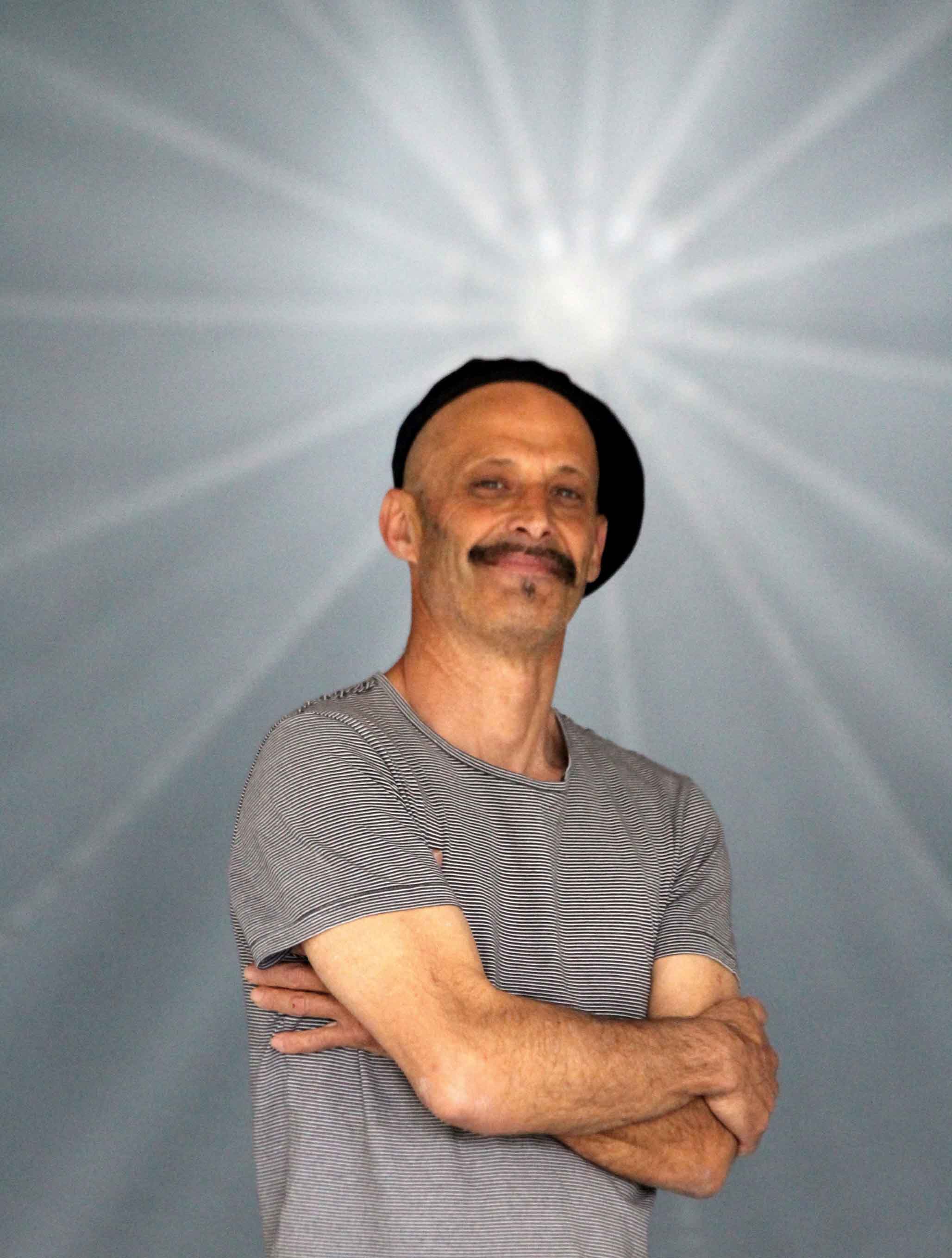Pulse (Spanda)
07.05.2022 – 22.05.2022
When men roll it up
Space as if it were a skin, then the end of pain will come without knowing God.
Śvetāśvatara-upaniṣad
Much of my artistic work revolves around the concept of limit as a dividing line that separates an interior from the exterior. Limits build, make it possible to live where there was space before.
So from the beginning I was very attracted to containers, which I understood as metaphors of being. The signifier lay in the way these limits were constructed or deconstructed. Often the difference between being (inside) and not being (outside) was represented by containers that dissolved, broke after spinning in precarious balance, sank, buried, swelled or deflated, and eventually became part of the whole.
There is an artistic intuition, given that many of my works involuntarily go in that direction, which suggests to me that there is little difference between the inside and the outside, separated by that thin membrane that we call “being”. We are the echo of the outside and we constantly build what is outside.
The word Spanda, which from Sanskrit alludes to the primordial pulsation or creative vibration throughout the universe *, serves to frame the work that will be installed at the DAC Contemporary Art, where the viewer is faced with a large oval (diaphragm) that it breathes and moves as if it were a wave. Space is intrinsically connected to time and the subject transits in the interval between the two limits of breath. This membrane (matrix) could be considered as a threshold that changes continuously from its concave shape, which invites the visitor to scrutinize the empty space, to the convex shape, which slowly invades the room forcing the spectators to retreat.
I like to underline the apparent duality between presence and emptiness, internal and external, welcome and thrust, feminine and masculine; Apparent because it is the same membrane that, thanks to the atmospheric pressure differences, passes from one side of the room to the other.
Most of the time the viewer remains in the territory between inhalation and exhalation, where everything is possible; the membrane becomes pure plastic possibility, like the waves, all similar but none alike.
Thus Pulse (Spanda) responds to the intuition that we are no longer the only ones to pass through immobile and passive space, but that space also moves around us.
Nothing stands still, everything pulsates.
* It coincides with the latest discoveries in quantum physics in which among other things it has been shown that there is not so much separation between the observer and the observed object, one influences the other. Everything is vibrant energy.
Quando gli uomini arrotoleranno lo
Spazio come se se fosse una pelle, allora verrà la fine del dolore senza conoscere Dio.
Śvetāśvatara-upaniṣad
Gran parte del mio lavoro artistico ruota intorno al concetto di límite come linea di demarcazione che separa un interno dall’esterno. I limiti costruiscono, rendono possibile l’abitare dove prima c’era spazio.
Così fin dall’inizio sono stato molto attratto dai contenitori, che ho inteso come metafore dell’essere. Il significante si trovava nel modo in cui questi limiti erano costruiti o decostruiti. Spesso la differenza tra essere (dentro) e non essere (fuori) era rappresentata da contenitori che si dissolvevano, si rompevano dopo aver ruotato in equilibrio precario, affondavano, si seppellivano, si gonfiavano o sgonfiavano e alla fine diventavano parte del tutto.
C’è un’intuizione artistica, visto che molte delle mie opere vanno involontariamente in quella direzione, che mi suggerísce che c’è poca differenza tra il dentro e il fuori, separati da quella sottile membrana che chiamiamo “l’essere”. Noi siamo l’eco del fuori e ciò che è fuori lo costruiamo costantemente.
La parola Spanda, che dal sanscrito allude alla pulsazione primordiale o vibrazione creativa in tutto l’universo*, serve a inquadrare l’opera che sarà installata al DAC Arte contemporanea, dove lo spettatore si trova di fronte a un grande ovale (diaframma) che respira e si muove come se fosse un’onda. Lo spazio è intrinsecamente connesso al tempo e il soggetto transita nell’intervallo tra i due limiti del respiro. Questa membrana (matrice) potrebbe essere considerata come una soglia che cambia continuamente dalla sua forma concava, che invita il visitatore a scrutare lo spazio vuoto, alla forma convessa, che invade lentamente la stanza costringendo gli spettatori a ritirarsi.
Mi piace sottolineare l’apparente dualità tra presenza e vuoto, interno ed esterno, accoglienza e spinta, femminile e maschile; Apparente perché è la stessa membrana che grazie alle differenze di pressione atmosferica passa da un lato all’altro dello spazio della sala.
La maggior parte del tempo lo spettatore rimane nel territorio tra inspirazione ed espirazione, dove tutto è possibile; la membrana diventa pura possibilità plastica, come le onde, tutte simili ma nessuna uguale.
Così Pulse (Spanda) risponde all’intuizione che non siamo più gli unici a transitare lo spazio immobile e passivo, ma che anche lo spazio si muove intorno a noi.
Niente è fermo, tutto pulsa.
* Coincide con le ultime scoperte della fisica quantistica in cui tra l’altro si è dimostrato che non c’è tanta separazione tra il soggetto osservatore e l’oggetto osservato, uno influenza l’altro. Tutto è energia vibrante.
Quand les hommes l’enroulent,l’espace comme s’il s’agissait d’une peau, alors la fin de la douleur viendra sans connaître Dieu.
Śvetāśvatara-upaniṣad
Une grande partie de mon travail artistique tourne autour du concept de limite en tant que
ligne de démarcation qui sépare un intérieur de l’extérieur. Les limites construisent, permettent de vivre là où il y avait de l’espace avant.
Donc dès le début j’ai été très attiré par les contenants, que j’ai compris comme des métaphores de l’être. Le signifiant résidait dans la manière dont ces limites étaient construites ou déconstruites. Souvent, la différence entre être (à l’intérieur) et ne pas être (à l’extérieur) était représentée par des conteneurs qui se dissolvaient, se brisaient après avoir tourné dans un équilibre précaire, coulaient, s’enfouissaient, gonflaient ou se dégonflaient, et finissaient par faire partie du tout.
Il y a une intuition artistique, étant donné que beaucoup de mes œuvres vont involontairement dans cette direction, qui me suggère qu’il y a peu de différence entre l’intérieur et l’extérieur, séparés par cette fine membrane qu’on appelle « l’être ». Nous sommes l’écho du dehors et nous construisons constamment ce qui est dehors.
Le mot Spanda, qui du sanskrit fait allusion à la pulsation primordiale ou vibration créatrice dans tout l’univers*, sert à encadrer l’œuvre qui sera installée au DAC Art Contemporain, où le spectateur est face à un grand ovale (diaphragme) qu’il respire et se déplace comme s’il s’agissait d’une vague. L’espace est intrinsèquement lié au temps et le sujet transite dans l’intervalle entre les deux limites du souffle. Cette membrane (matrice) pourrait être considérée comme un seuil qui change continuellement de sa forme concave, qui invite le visiteur à scruter l’espace vide, à la forme convexe, qui envahit lentement la pièce obligeant les spectateurs à reculer.
J’aime souligner l’apparente dualité entre présence et vide, intérieur et extérieur, accueil et poussée, féminin et masculin ; Apparent car c’est la même membrane qui, grâce aux différences de pression atmosphérique, passe d’un côté à l’autre de la pièce.
La plupart du temps, le spectateur reste dans le territoire entre inspiration et expiration, là où tout est possible ; la membrane devient une pure possibilité plastique, comme les ondes, toutes semblables mais pas pareilles.
Ainsi Pulse (Spanda) répond à l’intuition que nous ne sommes plus les seuls à traverser l’espace immobile et passif, mais que l’espace bouge aussi autour de nous.
Rien ne s’arrête, tout vibre.
* Cela coïncide avec les dernières découvertes en physique quantique dans lesquelles, entre autres, il a été démontré qu’il n’y a pas tellement de séparation entre l’observateur et l’objet observé, l’un influençant l’autre. Tout est énergie vibrante.
